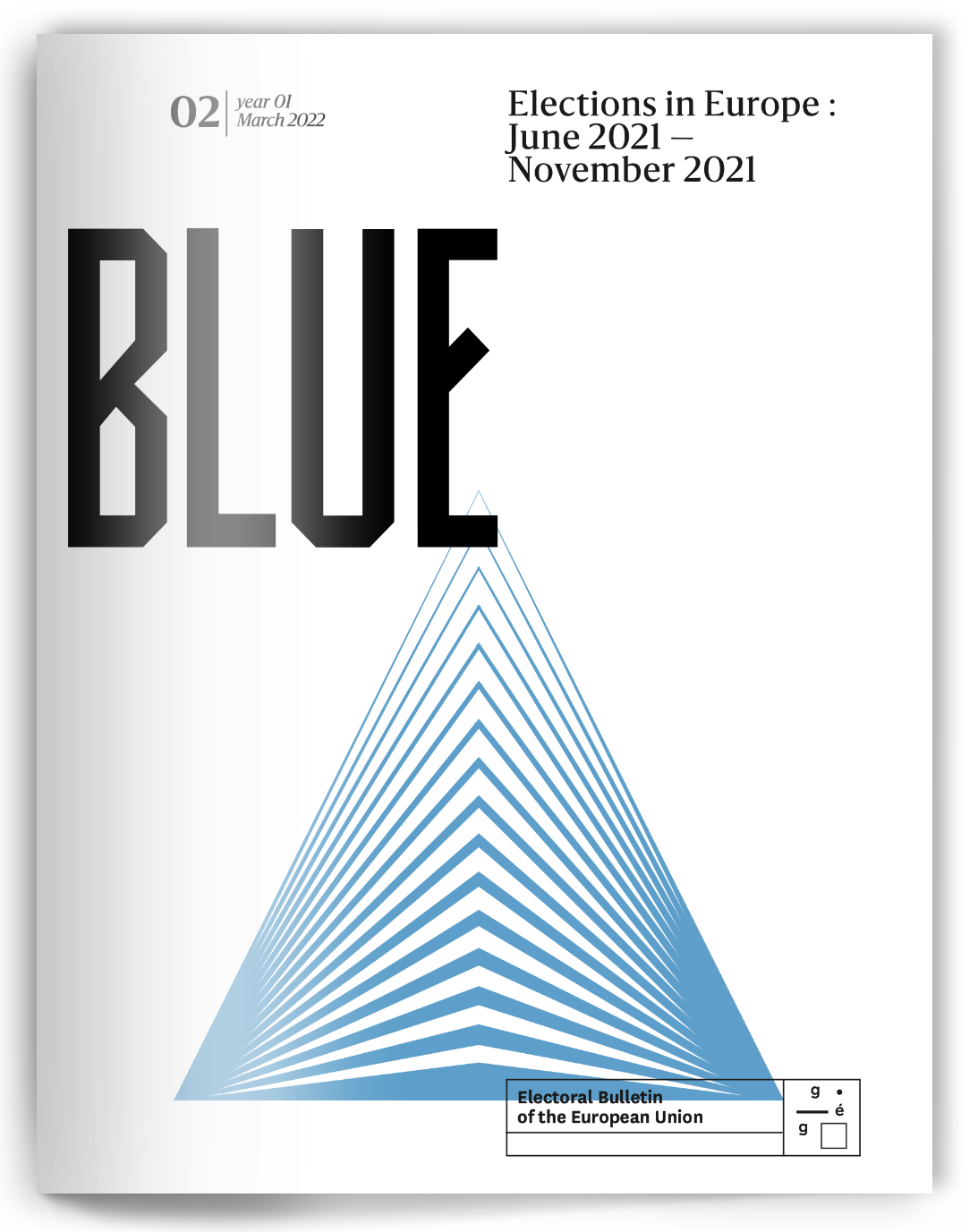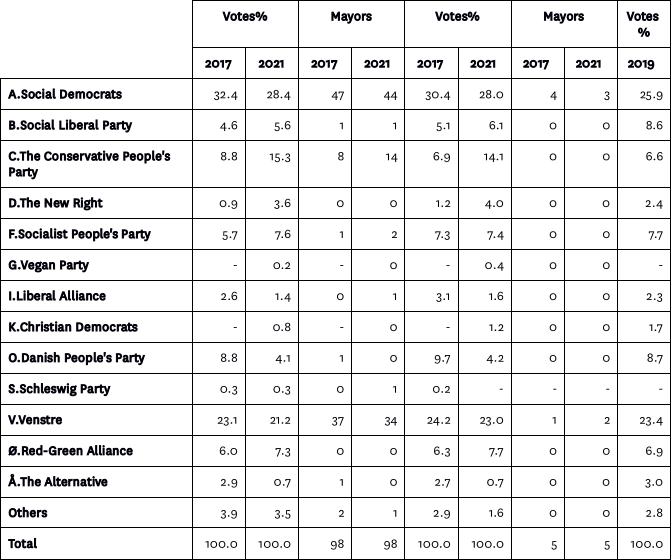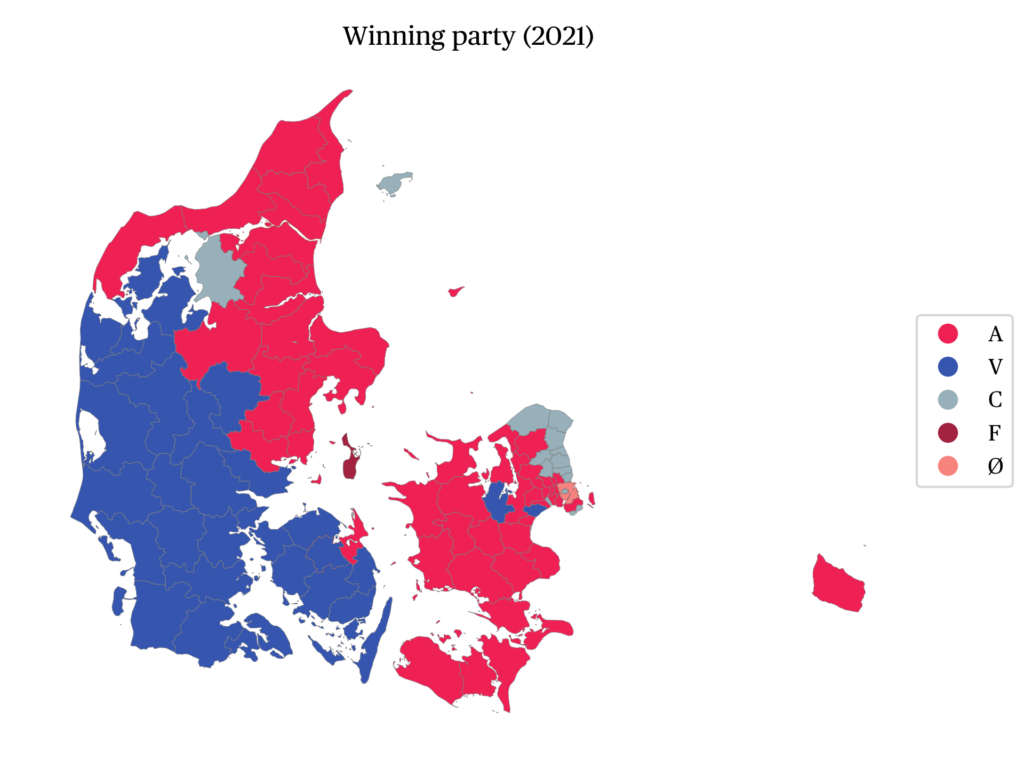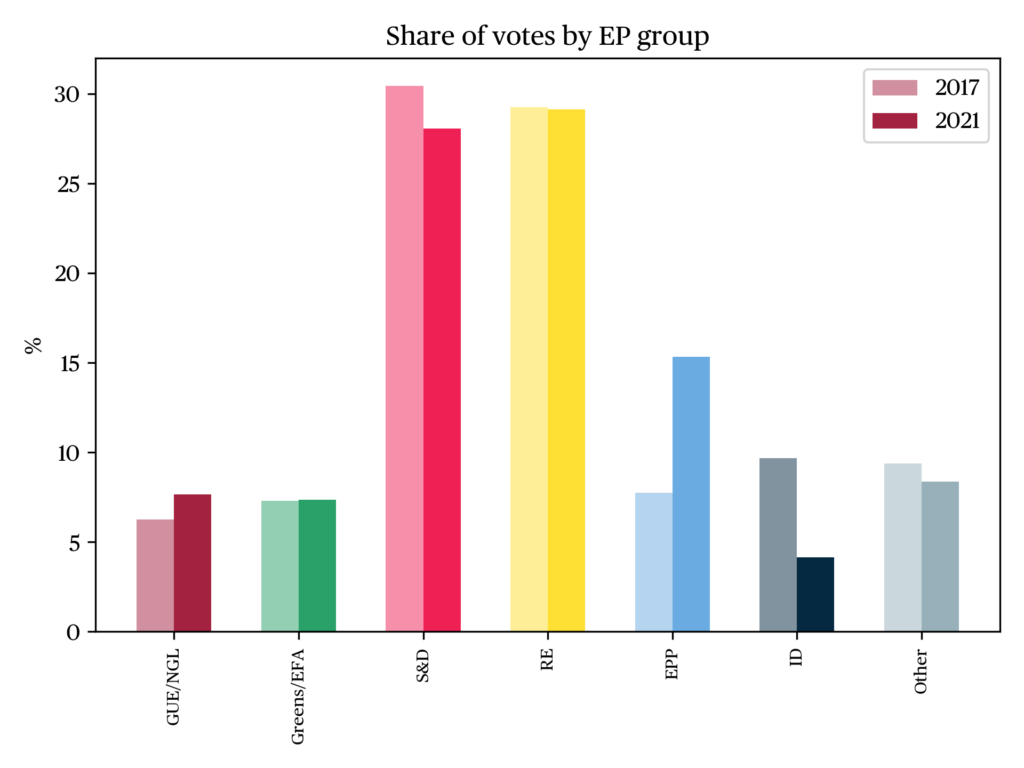Regional and municipal elections in Denmark, 16 November 2021
Ulrik Kjær
Researcher in political science at Syddansk UniversitetIssue
Issue #2Auteurs
Ulrik Kjær
21x29,7cm - 167 pages Issue 2, March 2021 24,00€
Elections in Europe : June 2021 – November 2021
On November 16, 2021, local elections were held in all of the 98 municipalities and the five regions of Denmark. The electoral cycle is fixed with municipal and regional elections held simultaneously every fouth year on the third Tuesday of November (see also Kjaer 2020a, 2020b). The 2021 elections were held in the middle of the COVID-19 pandemic and although special measures were introduced around the voting procedure, the turnout decreased slightly. As for the electoral results, the swings in national politics seems to have had a larger-than-usual impact on the local elections.
The context
The current structure of local governments was created by a major reform in 2007 amalgamating 275 municipalities into 98 and 14 regions into five. Local governments in Denmark are quite important, with municipalities responsible for approximately half the public expenditures (48% in 2020) and regions responsible for one quarter (25% in 2020). In a country with a large public sector, this also means that the local governments’ budget accounts for a third of the GDP of Denmark. The municipalities are truly multi-purpose, with a task portfolio including as diverse a set of task as primary schools, elderly care, child care, social care, housing, planning, employment initiatives, cultural activities, parks, water, sewage and waste management. The regions are primarily responsible for health care and run the hospitals.
On election day, voters are handed over two ballots when they go to the pollings stations (of which there are 1,383) — a white-coloured one for the municipal election and a yellow-coloured for the regional election. And Danes vote. At the municipal elections the participation rate was as high as 67,2% and at the regional elections 67,0%. And this was even a decrease compared to the latest local elections of 2017, where 70,8% and 70,7%, respectively, cast a vote. For comparison, the turnout was 84,5% at the latest parliamentary election (June 5, 2019) and 66,0% at the latest elections for the European Parliament (May 26, 2019). It should be noticed that the number of COVID-19 cases in Denmark rose very significantly during the last week before the elections and, therefore, the decreasing turnout might have been a result of this. Measures were taken to have voters show up at the polling stations even though they were nervous about the COVID-19 situation: for instance, voters were allowed to bring thir own pencil to mark the ballot with, instead of using the one available in the polling booth (which is normally the only option accepted). Moreover, voters infected with COVID-19 could vote from their car and did not have to enter the polling station. The media did what they could to get a high turnout — in Denmark local elections and the local candidates are covered very extensively by the national, regional and local media (for instance, the two major national TV networks broadcast live all night on election day), and this coverage is not in decline, almost the opposite.
The results
The local party systems in Denmark are truly multi-party systems and also quite nationalized – the many political parties running and getting elected in parliamentary politics are also contesting each other in most municipalities and regions. The entry barriers to run at municipal elections are quite low (only signatures from 25 voters are required), and therefore non-partisan lists are also running in most municipalities. However, many of the parties running have an official ”designated letter” which means that they can run under the same label in all municipalities and regions where they run, namely the official letter and name of their nationwide party. The parties which are allowed to run at the parliamentary elections have such a designated letter — at the time of the 2021 local elections, this amounted to twelve parties (supplemented with the German minority party which is designated the letter S in the part of Denmark bordering Germany). As can be seen from Table 1, the nationwide parties dominated the municipal and regional elections (with 96 and 97% of the votes, respectively). The local lists are weak in almost all municipalities and totally absent in the largest cities. There is no formal threshold to pass to get represented, but with the number of seats at the councils varying from 9 to 31 (55 in the capital of Copenhagen), the natural threshold is quite high — in an average municipality with 25 seats, it takes 4% of the votes to get represented. Each of the Regional Assemblies have 41 seats, and therefore the natural threshold is slighly lower here.
Table 1 also demonstrates that the two parties traditionally dominating local politics in Denmark — the Social Democrats and the Liberal Party — were very present and popular also this time. They are the biggest parties and usually win the lion’s share of the municipal and regional mayoralties (as well the Mayor in the municipalities as the Chairman of the Regional Assembly in the regions is indirectly elected by and among the councillors). However, as can also be seen from Figure a, the Conservative People’s Party had a very good election, almost doubling their vote share and their number of municipal mayors — an increase which very much confirmed the succes of the party in the national opinion polls. So, in Denmark — as it has been labelled — ”two-and-a-half parties rule within a multi-party system” (Kjaer 2022).
However, the most pronounced electoral change was the defeat experienced by the Danish People’s Party. This populist, somewhat right-wing, party which at the 2015 general election became the largest party of the opposition, had a very tough election. Their vote share decreased in all municipalities and regions: the party won only 91 seats across municipalities, down from 223 in 2017 and six seats across regions down from 21 in 2017. As a result, the chairman of the party, Kristian Thulesen Dahl, declared right after the local elections that he, as a consequence of the result, would step down as party leader. Never before have local elections in Denmark have had such consequences for the national leadership of a party.
As for the two major parties, Social Democrats and Liberal Party, both of them experienced a decrease in electoral support. However, just months before the elections, Social Democrats were doing rather well in the national polls, while the Liberal Party was performing quite badly (a situation which changed in the last months before the local elections). Therefore, in relative terms Social Democrats were having a worse election result than expected, while the Liberal Party was probably relieved that they got away with a relatively small electoral defeat (and for instance keeping most of their mayoralties). In each of the four biggest municipalities (Copenhagen, Aarhus, Aalborg and Odense), however, the loss of the Social Democrats was as big as around 10 percentage points, which not only came as a surprise to most pundits but also hit the Social Democrats hard, since in these cities they have historically almost monopolized power. Even though they kept the mayoralty in all four cities, not least the electoral defeat in the capital of Copenhagen was sensational, since Social Democrats is no longer the largest party — a position which is now held by the extreme left party Red-Green Alliance.

Note: *The results of an opinion poll conducted rigth before the elections asking respondents what they would vote in a parliamentary election if ”one was held tomorrow” publicized by Berlingske Barometer.
Source: Statistics Denmark (local elections 2017 and parliamentary elections 2019), TV2 (local elections 2021), Berlingske barometer 14.11.21 (parliamentary election poll 2021) and The Danish Mayoral Archive (mayoralties 2017 and 2021).
The dramas
As could be expected when 103 elections (98 municipal and five regional) are held on the same day, electoral dramas occur. At the 2021 local elections, a number of government coalition formation processes were difficult, with the name of the mayor changing a few times in the weeks from the elections to the first meeting of the council where the mayor is formally selected. However, the biggest headlines of the 2021 elections were probably made in three other municipalities:
- In Kolding municipality, the former foreign minister of Denmark ran for his party Socialist People’s Party challenging the mayoral party Liberal Party, who (therefore?) ended up running former minister of agriculture, Eva Kjer Hansen. Much attention was paid to this ”presidential campaign”, not least by the nationwide media. It then turned out that neither party won an absolute majority and in the process of finding a mayor, the frontrunner from the Conservative People’s Party, Knud Erik Langhoff, turned out to be the best negotiator and to much surprise, and almost out of nowhere, became the new mayor.
- In Holbæk municipality, Christina Krzyrosiak Hansen from the Social Democrats became the youngest mayor in Denmark when she at the age of 24 took office after the 2017 elections. Some commentators pointed to her young age and lack of experience as a problem, but they were proved wrong at the 2021 elections — no less than 46% of the voters cast a preferential vote for her (and this was by far the highest percentage across the 98 municipalities).
- In Frederiksberg municipality, which is the 7th-largest municipality in Denmark and located within the borders of Copenhagen, the Conservative People’s Party lost the mayoralty. This was quite a defeat since Frederiksberg is the quintessential conservative municipality and has been a conservative stronghold for many years. In fact, this was the first election in 112 years where the Conservetives did not conquer the mayoralty: the mayoralty it went to a Social Democrat.
Of course other municipalities would claim that their electoral result was also outstanding, but this was to mention the most obvious. Across the municipalities and regions different patterns can also be observed. For instance ,103 women got elected to the regional councils compared to 102 men, which means that for the first time ever, women are more than half of the regional councillors (also at the municipal level, a record-high number of women were elected, but here it was a more modest 36%). It should be noticed that there are no formal gender quotas in Denmark.
However, more analyses are needed of the elections to point out more patterns. These analyses will be conducted in the coming months and years when the electoral statistics are published and not least when the results from the survey from the Danish Local Election Study is made available. However, as a first conclusion it should be assessed that the 2021 local elections were more mid-term elections than what is usually seen in Denmark. Several of the nationwide parties had something at stake, and the national swings seems to have been more important for the local electoral results than usually. The spectacular stepping down of Kristian Thulesen Dahl as party chairman of Danish People’s Party is a case in point, since the end of his tenure was a result of how the party soldiers in the 98 municipalities and five regions performed.
Literature
Kjær, U. (2020a). Local Elections — Localized Voting Within a Nationalized Party System. In Christiansen P. M. et al. (eds.), Oxford Handbook of Danish Politics, Oxford: Oxford University Press, pp. 382-399.
Kjær, U. (2020b). The 2017 Danish regional elections and the victorious parliamentary parties. Regional & Federal Studies, 30, 3, pp. 461-473.
Kjær, U. (2022). Denmark — How two-and-a-half parties rule within a multi-party system. In Gendźwiłł, A. et al., The Routledge Handbook of Local Elections and Voting in Europe, London: Routledge, pp. 21-30.
citer l'article
Ulrik Kjær, Regional and municipal elections in Denmark, 16 November 2021, Mar 2022, 141-144.
à lire dans cette issue
voir toute la revue









